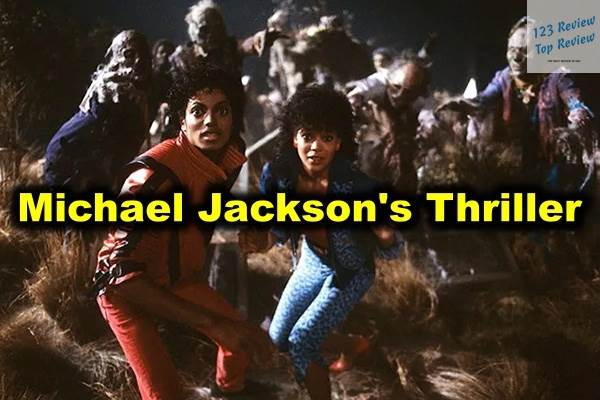In this article, 123 Review explores the groundbreaking production techniques, iconic music videos, and lasting cultural significance of Thriller, while analyzing its most memorable tracks and the critical acclaim it continues to receive. Dive into the legacy of the best-selling album of all time and discover why Thriller remains a timeless masterpiece.
Album Overview
Release Date and Background
On November 30, 1982, the world witnessed the release of an album that would not only define a generation but also transform the landscape of popular music forever—Michael Jackson’s Thriller. This album was not just a collection of songs; it was a cultural phenomenon that transcended musical genres and geographical boundaries. Coming off the success of his 1979 album Off the Wall, Jackson was determined to push the boundaries even further. He wanted to create an album that would resonate with a global audience and solidify his position as the preeminent artist of his time.

The pressure to surpass the success of Off the Wall was immense. Michael Jackson, alongside his trusted collaborator and producer Quincy Jones, set out to create an album that would break new ground. Jackson was meticulous in his approach, spending countless hours in the studio, perfecting every note and every beat. He was driven by a singular vision: to create an album that would appeal to everyone, regardless of age, race, or nationality. This ambition was reflected in the album’s eclectic mix of musical styles, ranging from pop and rock to R&B and funk.
Thriller was more than just a musical endeavor; it was a carefully orchestrated project that involved a team of some of the most talented musicians, songwriters, and producers of the time. The album was recorded over the course of eight months, with sessions taking place at Westlake Recording Studios in Los Angeles. Every aspect of the album, from the production to the marketing, was meticulously planned to ensure its success. Jackson’s perfectionism and attention to detail paid off, as Thriller went on to become the best-selling album of all time, with estimated sales exceeding 66 million copies worldwide.
Notable Collaborations
One of the key factors behind the success of Thriller was the impressive lineup of collaborators who contributed to the album. Michael Jackson was known for his ability to bring together some of the biggest names in the music industry, and Thriller was no exception. The album featured collaborations with a diverse range of artists, each of whom brought their unique talents to the table.
The first single from the album, “The Girl Is Mine,” was a duet with Paul McCartney, one of the most influential musicians of the 20th century. The collaboration was a significant moment in music history, as it brought together two of the biggest stars from different eras. The song, with its playful lyrics and catchy melody, became an instant hit and helped to set the tone for the album.
Another standout collaboration on the album was with guitarist Eddie Van Halen, who delivered an unforgettable guitar solo on the track “Beat It.” Van Halen’s contribution was groundbreaking, as it fused rock and pop in a way that had never been done before. The solo added a layer of intensity to the song, making it one of the most memorable tracks on the album. The collaboration between Jackson and Van Halen was a testament to Jackson’s willingness to experiment with different musical styles and push the boundaries of what pop music could be.
Quincy Jones, the legendary producer who had worked with Jackson on Off the Wall, played a crucial role in the creation of Thriller. Jones’ experience and expertise were instrumental in shaping the sound of the album. He worked closely with Jackson to develop the album’s unique blend of genres, ensuring that each track was polished to perfection. Jones also brought in some of the industry’s top session musicians, including keyboardist Greg Phillinganes and bassist Louis Johnson, to contribute to the album’s rich and layered sound.
In addition to these high-profile collaborations, Thriller also featured contributions from a team of talented songwriters, including Rod Temperton, who penned the title track. Temperton, who had previously worked with Jackson on Off the Wall, was known for his ability to craft catchy, radio-friendly songs. His work on Thriller was no exception, as the title track became one of the most iconic songs in music history.
Impact on Pop Music
Thriller did more than just dominate the charts; it revolutionized the pop music industry and set a new standard for what an album could achieve. The album’s success was not just a testament to Jackson’s talent, but also to his ability to tap into the cultural zeitgeist of the early 1980s. Thriller was a reflection of the era’s evolving musical tastes, as it seamlessly blended elements of pop, rock, R&B, and funk to create a sound that was both innovative and accessible.
One of the most significant impacts of Thriller was its role in breaking down racial barriers in the music industry. At the time of its release, the music industry was still largely segregated, with black artists often relegated to the R&B charts while white artists dominated the pop and rock charts. Thriller transcended these divisions, appealing to a diverse audience and proving that music could be a unifying force. The album’s crossover success helped to pave the way for other black artists to achieve mainstream recognition and success.
The production quality of Thriller was also a game-changer for the industry. Quincy Jones and Michael Jackson pushed the boundaries of what was possible in the studio, using the latest technology and recording techniques to create a sound that was crisp, polished, and dynamic. The album’s meticulous production set a new standard for pop music, influencing countless artists and producers in the years that followed.
The impact of Thriller extended beyond the music itself. The album’s innovative use of music videos as a promotional tool helped to revolutionize the way music was marketed. The music video for the title track, “Thriller,” was a groundbreaking achievement that set a new standard for the medium. Directed by John Landis, the video was more than just a visual accompaniment to the song; it was a cinematic experience that captivated audiences and became a cultural phenomenon in its own right.
Thriller also had a lasting impact on the live music industry. The album’s success allowed Jackson to embark on the Victory Tour in 1984, which was one of the most successful concert tours of the decade. The tour’s elaborate stage production, with its intricate choreography and state-of-the-art technology, set a new standard for live performances and influenced the way concerts were staged for years to come.
Track Analysis
Key Tracks Breakdown
The brilliance of Thriller lies in its ability to offer something for everyone. Each of the nine tracks on the album brings a unique flavor to the table, contributing to the album’s overall appeal and enduring legacy. The album kicks off with “Wanna Be Startin’ Somethin’,” a high-energy track that sets the tone for what’s to come. The song’s complex rhythms and infectious groove make it an instant standout, showcasing Jackson’s ability to create music that is both danceable and thought-provoking.
The title track, “Thriller,” is perhaps the most iconic song on the album, if not in Michael Jackson’s entire career. The song’s eerie, horror-inspired lyrics, combined with its unforgettable bassline and Vincent Price’s spooky spoken-word interlude, create a haunting atmosphere that is both captivating and unsettling. The song’s accompanying music video, with its groundbreaking special effects and elaborate choreography, further cemented its place in pop culture history.
“Beat It,” another standout track, is a perfect example of Jackson’s ability to blend genres. The song’s rock-infused sound, highlighted by Eddie Van Halen’s blistering guitar solo, helped to bridge the gap between rock and pop, making it a crossover hit that appealed to a wide audience. The song’s anti-violence message, delivered through its lyrics and the iconic music video, resonated with listeners and showcased Jackson’s commitment to using his music to address social issues.
“Billie Jean,” with its unforgettable bassline and lyrics that explore the darker side of fame, is arguably one of the most recognizable songs in music history. The song’s narrative, which tells the story of a fan’s false paternity claim, is both personal and universal, reflecting Jackson’s own experiences with the pressures of fame. The song’s music video, featuring Jackson’s legendary moonwalk, became a cultural touchstone and helped to solidify his status as a global icon.
The album also features “Human Nature,” a softer, more introspective track that contrasts with the album’s more upbeat songs. The song’s lush, atmospheric production and Jackson’s emotive vocals create a sense of intimacy that draws the listener in. “P.Y.T. (Pretty Young Thing)” is another standout, with its infectious groove and playful lyrics that celebrate youthful exuberance and romance.
Each track on Thriller is a carefully crafted masterpiece, contributing to the album’s overall success and making it a timeless work of art.
Lyrical Themes and Concepts
Thriller is not just a collection of catchy tunes; it’s an album that delves into a variety of themes and concepts, reflecting both Michael Jackson’s personal experiences and broader societal issues. The album’s lyrics explore themes of love, relationships, fame, and even the supernatural, offering a window into Jackson’s world and the cultural climate of the time.
“Billie Jean,” for example, addresses the darker side of fame, with its narrative of a fan’s false paternity claim. The song’s lyrics, “Billie Jean is not my lover / She’s just a girl who claims that I am the one,” reflect Jackson’s own experiences with the pressures of celebrity and the scrutiny that comes with it. The song’s themes of paranoia and mistrust resonate with listeners, offering a glimpse into the challenges of living in the public eye.
The title track, “Thriller,” taps into horror movie tropes, blending them with pop to create something uniquely eerie yet accessible. The song’s lyrics, “It’s close to midnight, and something evil’s lurking in the dark,” set the stage for a thrilling narrative that combines elements of suspense, fear, and excitement. The song’s use of Vincent Price’s spoken-word interlude adds to the song’s cinematic quality, making it a standout track that continues to captivate audiences.
“Beat It” addresses the issue of violence, with its message of nonviolence and conflict resolution. The song’s lyrics, “You better run, you better do what you can / Don’t wanna see no blood, don’t be a macho man,” encourage listeners to walk away from conflict rather than resort to violence. The song’s message, combined with its rock-infused sound, made it a powerful anthem for a generation.
Other tracks on the album, such as “Human Nature” and “P.Y.T. (Pretty Young Thing),” explore themes of love and romance. “Human Nature,” with its introspective lyrics and gentle melody, reflects on the complexities of human relationships and the desire for connection. “P.Y.T.,” on the other hand, is a celebration of youthful exuberance and the joys of love and attraction.
Production Techniques
The production of Thriller was nothing short of revolutionary, setting new standards for the music industry and influencing countless artists and producers in the years that followed. Quincy Jones and Michael Jackson were at the forefront of this innovation, utilizing the latest recording technology and techniques to create an album that was sonically ahead of its time.
One of the most notable aspects of the album’s production is its use of multi-layered vocal harmonies. Jackson’s voice is often layered multiple times to create a rich, full sound that adds depth and complexity to the songs. This technique is particularly evident on tracks like “Wanna Be Startin’ Somethin'” and “Thriller,” where Jackson’s vocals are harmonized to create a sense of grandeur and drama.
The album also makes extensive use of synthesizers and drum machines, which were cutting-edge technology at the time. The use of synthesizers allowed Jones and Jackson to create a wide range of sounds and textures, from the eerie, otherworldly tones of “Thriller” to the lush, atmospheric soundscapes of “Human Nature.” The drum machines, particularly the Linn LM-1, provided a crisp, precise rhythm that became a signature sound of the album.
Quincy Jones’ production expertise is also evident in the album’s meticulous attention to detail. Every aspect of the production, from the placement of microphones to the mixing and mastering, was carefully considered to ensure that the album sounded as polished and dynamic as possible. The result is an album that is not only musically diverse but also sonically pristine, with a clarity and depth that continues to impress listeners to this day.
The production of Thriller also involved the use of innovative recording techniques, such as “gated reverb,” which was used to create the distinctive snare drum sound on “Billie Jean.” This technique, which involves using a noise gate to cut off the reverb tail, gives the snare drum a punchy, impactful sound that became a hallmark of the album’s production.
Overall, the production of Thriller was a groundbreaking achievement that set a new standard for pop music and continues to influence the industry to this day.
Cultural Significance
Influence on Music Videos
One of the most significant aspects of Thriller‘s legacy is its influence on the music video medium. Before Thriller, music videos were primarily used as promotional tools, often consisting of simple performance footage or low-budget visuals. However, Michael Jackson’s vision for the “Thriller” music video changed the game entirely, transforming music videos into a legitimate art form.
Directed by John Landis, the “Thriller” music video was a 14-minute short film that combined elements of horror, dance, and narrative storytelling. The video featured elaborate choreography, special effects, and a cinematic plot, making it more of a mini-movie than a traditional music video. The iconic dance sequence, with Jackson leading a group of zombies in a synchronized routine, became one of the most memorable moments in music video history.
The “Thriller” music video was groundbreaking not only for its content but also for its impact on the industry. It was one of the first music videos to receive heavy rotation on MTV, helping to break down racial barriers on the network and paving the way for other black artists to gain visibility. The success of the “Thriller” video also demonstrated the power of music videos as a promotional tool, leading to an increase in the production value and creativity of music videos in the years that followed.
In addition to the “Thriller” video, other music videos from the album, such as “Beat It” and “Billie Jean,” also made a significant impact. The “Beat It” video, with its depiction of rival gangs coming together to dance, reinforced the song’s anti-violence message and showcased Jackson’s ability to use visual storytelling to complement his music. The “Billie Jean” video, with its iconic imagery of Jackson’s footsteps lighting up the sidewalk, became another cultural touchstone and solidified Jackson’s reputation as a visionary artist.
The influence of the “Thriller” music video can still be seen today, as artists continue to push the boundaries of the medium and use music videos as a way to express their artistic vision. The video has been parodied, referenced, and paid tribute to in countless films, TV shows, and other media, cementing its place in pop culture history.
Legacy in Pop Culture
The cultural significance of Thriller extends far beyond the music itself. The album, with its iconic imagery and groundbreaking music videos, has left an indelible mark on pop culture and continues to be referenced and celebrated to this day.
One of the most enduring images associated with Thriller is Michael Jackson’s red leather jacket, which he wore in the “Thriller” music video. The jacket, with its distinctive design and bold color, became a fashion statement and is still considered one of the most iconic pieces of clothing in music history. The jacket has been replicated and worn by fans and celebrities alike, and it remains a symbol of Jackson’s influence on fashion and pop culture.
The zombie dance sequence from the “Thriller” video has also become a cultural phenomenon in its own right. The choreography, created by Michael Peters and Jackson himself, has been imitated and parodied in countless movies, TV shows, and live performances. The dance has become a staple of Halloween parties and events, with people around the world donning zombie costumes and recreating the iconic routine.
In addition to its impact on fashion and dance, Thriller has also influenced a wide range of artists across different genres. Musicians, filmmakers, and visual artists have all drawn inspiration from the album’s innovative sound, groundbreaking visuals, and cultural significance. The album’s legacy can be seen in the work of artists such as Beyoncé, Kanye West, and Lady Gaga, who have cited Michael Jackson and Thriller as major influences on their careers.
The cultural impact of Thriller is also evident in the continued popularity of its tracks. Songs like “Billie Jean,” “Beat It,” and “Thriller” remain staples of popular playlists and are frequently covered and sampled by other artists. The album’s influence can also be seen in the way it has become synonymous with Halloween, with the title track and its music video becoming a perennial favorite during the spooky season.
Awards and Accolades
The critical and commercial success of Thriller was reflected in the numerous awards and accolades it received. At the 1984 Grammy Awards, Thriller made history by winning eight awards, including Album of the Year, making Michael Jackson the most awarded artist in a single night. The album also earned Jackson the Best Male Pop Vocal Performance award for “Thriller” and the Best Male R&B Vocal Performance award for “Billie Jean,” showcasing the album’s crossover appeal and Jackson’s versatility as an artist.
In addition to its Grammy wins, Thriller received numerous other accolades, including American Music Awards, Billboard Music Awards, and a special Award of Merit from the American Music Awards, recognizing Jackson’s contributions to the music industry. The album was also inducted into the Grammy Hall of Fame in 2008, further cementing its status as one of the greatest albums of all time.
Thriller has also achieved remarkable commercial success. It has been certified 34 times platinum by the RIAA, making it the best-selling album in the United States. Worldwide, the album’s sales have exceeded 66 million copies, making it the best-selling album of all time globally. These sales figures are a testament to the album’s universal appeal and its enduring popularity with audiences around the world.
In 2009, the Library of Congress added Thriller to the National Recording Registry, recognizing its cultural, historical, and aesthetic significance. This honor is reserved for recordings that are considered to be of lasting importance to American culture and history, further highlighting the album’s impact on the music industry and beyond.
Critical Reception
Contemporary Reviews
Upon its release, Thriller was met with widespread acclaim from critics and fans alike. The album was praised for its innovative sound, diverse musical styles, and Michael Jackson’s exceptional vocal performances. Critics recognized Thriller as a groundbreaking work that pushed the boundaries of what pop music could achieve.
Rolling Stone magazine called Thriller “a blockbuster,” noting that it was “an album that practically invents a new style of pop music.” The review praised Jackson’s ability to seamlessly blend different genres, from rock and funk to R&B and pop, creating a sound that was both fresh and familiar. The magazine also highlighted the album’s high production values, describing it as “a sonic marvel.”
The New York Times also lauded Thriller, calling it “the most eagerly awaited album of the year.” The review praised Jackson’s versatility as an artist, noting that the album showcased his ability to excel in a wide range of musical styles. The review also highlighted the album’s innovative production, particularly the use of synthesizers and drum machines, which gave the album a modern, cutting-edge sound.
Billboard magazine praised Thriller for its “relentless energy” and “unmatched creativity.” The review noted that the album was a testament to Jackson’s growth as an artist, showcasing his ability to evolve and adapt to the changing musical landscape. The review also praised Quincy Jones’ production, describing it as “masterful” and “ahead of its time.”
Overall, contemporary reviews of Thriller recognized it as a landmark album that would have a lasting impact on the music industry. The album’s critical success was matched by its commercial success, as it quickly climbed the charts and became one of the best-selling albums of all time.
Long-term Critical Analysis
In the decades since its release, Thriller has continued to receive praise and recognition as one of the greatest albums of all time. Critics have lauded the album’s enduring influence on popular music and its ability to resonate with new generations of listeners.
One of the most notable aspects of Thriller‘s legacy is its impact on the pop music genre. The album’s fusion of different musical styles, from pop and rock to R&B and funk, helped to redefine what pop music could be. Thriller set a new standard for pop albums, influencing countless artists and shaping the direction of the genre for years to come.
Critics have also noted the album’s influence on the music video medium. The “Thriller” music video is often cited as one of the greatest music videos of all time, and its impact on the industry cannot be overstated. The video helped to establish music videos as a legitimate art form, paving the way for future artists to use the medium as a platform for creative expression.
In addition to its impact on pop music and music videos, Thriller has also been recognized for its cultural significance. The album’s ability to break down racial barriers in the music industry and its influence on fashion, dance, and popular culture have all contributed to its status as a cultural touchstone.
Comparison with Other Albums
When comparing Thriller to other albums in Michael Jackson’s discography, it is clear that the album stands out as a defining moment in his career. While Off the Wall was a critical and commercial success, Thriller took Jackson’s career to new heights, establishing him as the “King of Pop” and solidifying his place in music history.
In comparison to Jackson’s later albums, such as Bad and Dangerous, Thriller remains the most iconic and influential. While both Bad and Dangerous were successful in their own right, neither achieved the same level of cultural impact or commercial success as Thriller. The album’s ability to transcend genres and appeal to a wide audience has made it a timeless classic that continues to be celebrated by fans and critics alike.
Conclusion
Lasting Impressions
Thriller is more than just an album; it is a cultural phenomenon that has left an indelible mark on the music industry and popular culture. From its innovative production techniques and groundbreaking music videos to its influence on fashion and dance, the album has had a lasting impact that continues to be felt today.
Michael Jackson’s vision and artistry, combined with Quincy Jones’ masterful production, resulted in an album that pushed the boundaries of what pop music could achieve. Thriller‘s ability to blend different musical styles and appeal to a diverse audience set a new standard for pop albums, influencing countless artists and shaping the direction of the genre for decades to come.
The album’s cultural significance is also evident in its ability to break down racial barriers in the music industry and its influence on popular culture. From the iconic “Thriller” music video to Jackson’s red leather jacket, the album’s imagery and style have become synonymous with the 1980s and continue to be referenced and celebrated in popular culture today.
Future of Thriller in Music History
As we look to the future, it is clear that Thriller will continue to hold a special place in music history. The album’s influence on the music industry and popular culture is undeniable, and its legacy will continue to inspire future generations of artists and fans.
Thriller‘s ability to resonate with listeners of all ages and backgrounds ensures that it will remain a timeless classic for years to come. As new technologies and musical trends emerge, the album’s innovative production techniques and genre-blending approach will continue to serve as a benchmark for excellence in pop music.
In the years to come, Thriller will undoubtedly continue to be celebrated and studied as one of the greatest albums of all time. Its impact on the music industry and popular culture is a testament to Michael Jackson’s unparalleled talent and vision, and its legacy will endure as long as there are people who love music.





